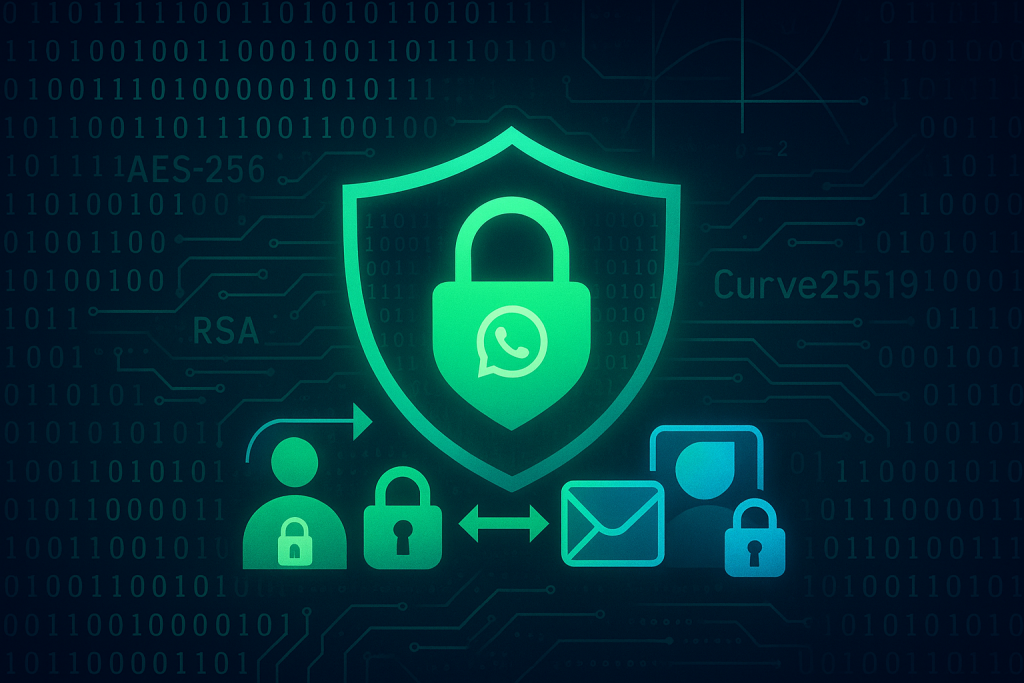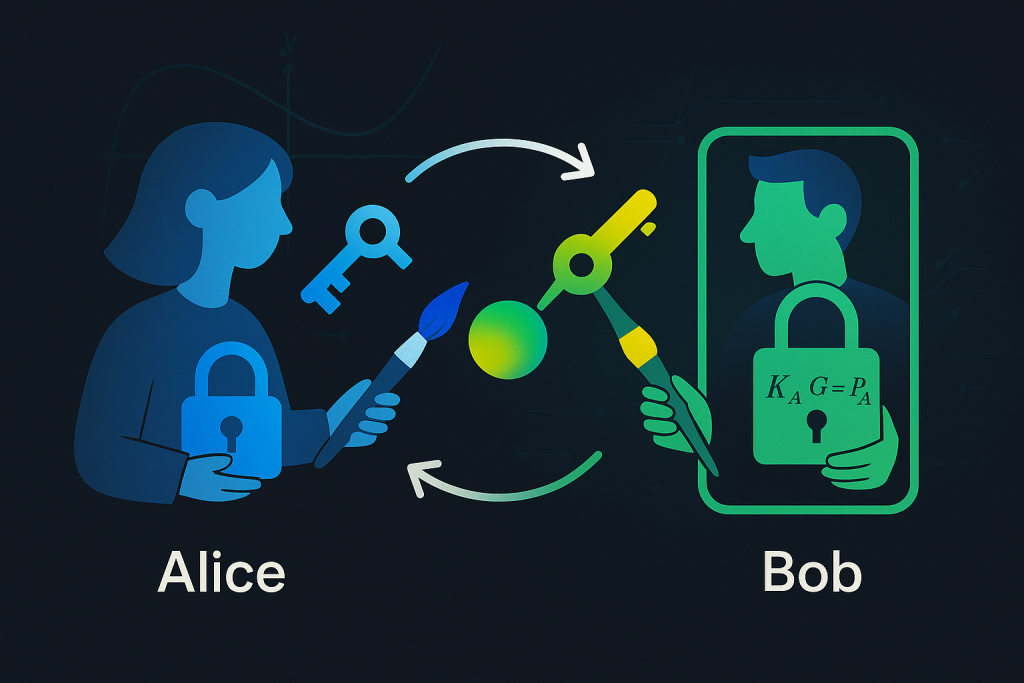Physical Address
304 North Cardinal St.
Dorchester Center, MA 02124
Physical Address
304 North Cardinal St.
Dorchester Center, MA 02124

End-to-end encryption is a secure communication method where only the communicating users can decrypt the messages. Think of it as each message being sealed in a vault that only you and the recipient can open. When you send a text, photo, or call via WhatsApp, the app encrypts it on your phone and only decrypts it on your friend’s phone . No intermediate server, hacker, or even WhatsApp’s own staff can peek inside. For example, if you text “Hello”, WhatsApp converts it into indecipherable code (using a cryptographic algorithm) before it leaves your device. Only your friend’s device, with the matching key, can turn that code back into “Hello”. This ensures personal chats remain private, like a face-to-face conversation in a secure room .
🎙️ Listen:Rust: End-to-End Encryption

Importantly, WhatsApp’s E2EE covers one-on-one messages, group chats, voice calls, video calls, and even shared media. Everything is encrypted on your device and only unlocked on the recipients’ devices . If someone intercepted the encrypted message in transit, all they’d see is gibberish. This robust privacy is “on” by default – indicated by the banner noting “Messages are end-to-end encrypted” in your chats – so you don’t have to be a tech expert to get secure communications.
WhatsApp’s security is built on an open-source cryptographic system called the Signal Protocol . This protocol, originally developed for the Signal messenger app, provides the mathematical tricks that make E2EE possible. At a high level, it works by giving each user a pair of long keys: a public key (which can be shared) and a private key (which is kept secret on your device) . Think of the public key as an open padlock you give to others, and your private key as the only key that can open that padlock.

When you message someone for the first time, both phones perform a lightning-fast Diffie-Hellman “handshake.” Each mixes its own private key with the other’s public key to generate a shared secret—much like two people blending hidden paint with a public color to create the same new shade that no outsider can guess. That secret immediately becomes the lock-and-key for all future messages in the chat.
Because the math is strictly one-way, anyone eavesdropping sees only useless numbers. WhatsApp implements this exchange on the efficient Curve25519 elliptic curve, delivering roughly 256-bit strength without slowing your phone—essentially two users agreeing on a 77-digit password in plain sight while keeping it indecipherable to everyone else.
Establishing a shared secret is just the beginning. WhatsApp goes further by changing encryption keys for every single message (or every small batch of messages) . This constant key rotation is a feature of the Signal Protocol that provides perfect forward secrecy. In practice, your app and your friend’s app generate new temporary key pairs and derive new shared keys frequently as the conversation progresses . Each message you send is encrypted with a fresh sub-key derived from the previous key, like an evolving lock that changes with each turn of the key.

Why do this? Because even in the unlikely event that an attacker somehow obtained a future or past key, they still couldn’t read other messages. For example, if message #50’s key is compromised, it won’t help decrypt message #51 or #49. The keys “ratchet” forward and expire immediately after use . This means your past conversations stay safe even if your current session’s security is somehow breached. It’s like changing the lock every time you send a letter – a stolen key from one envelope won’t open any others. This forward secrecy is a massive win for user privacy and security, ensuring that WhatsApp chats remain confidential even under evolving threat conditions.
All the key exchanges and handshakes ultimately serve to agree on secret keys – but what about the actual message content encryption? WhatsApp uses proven, industry-standard encryption algorithms to lock down the content of your messages. Specifically, once a message key is established (as described above), WhatsApp applies the Advanced Encryption Standard (AES) with 256-bit keys in an encryption mode to scramble your message . AES-256 is a symmetric cipher regarded as virtually unbreakable by today’s supercomputers . It’s the same level of encryption used by banks and governments for top-secret data.

AES-256 acts like an ultra-tough padlock: your message is scrambled with a 256-bit key that only you and your chat partner possess, making brute-force cracking practically impossible for today’s computers. WhatsApp also attaches an HMAC-SHA-256 “tamper seal,” so if anyone tweaks the ciphertext en route, the recipient’s app spots the change and discards it—keeping each message both private and authentic.
All this heavy cryptography runs silently behind the scenes; you only notice a little lock icon confirming it’s on. Group chats follow the same playbook: a shared group key lets current members decrypt messages, and that key automatically refreshes whenever someone joins or leaves, ensuring only intended participants can read the conversation.
End-to-end encryption hides what you say, not when or to whom you say it. WhatsApp can still see message metadata—like your contacts, timestamps, and attachment sizes—because those details are needed to route traffic. So while the content stays secret, the “envelope” information remains visible on WhatsApp’s servers and could reveal communication patterns.
Cloud backups are another gap. A chat you save to Google Drive or iCloud is only as private as that storage account unless you switch on WhatsApp’s optional end-to-end encrypted backup. Enable it, set a strong password, and the backup is locked with a key that only you hold; otherwise, anyone who gains access to your cloud account—or the provider itself—could open your archived chats.
Finally, E2EE can’t protect messages displayed on an unlocked phone. Malware, shoulder-surfers, or phishing attacks that steal your six-digit SMS code or cloud credentials can still compromise your chats. Basic hygiene—screen locks, up-to-date software, and caution with verification codes—remains essential to keep your private conversations truly private.
WhatsApp’s end-to-end encryption marries advanced mathematics with everyday messaging to provide a high level of security. In essence, WhatsApp turned your phone into a fortress for your texts, securing each message with unbreakable codes that only you and the intended recipient can unlock . The Signal Protocol’s ingenious use of constantly evolving keys means that your privacy isn’t just protected now – it stays protected even if someone tries to compromise keys in the future . All of this happens behind the scenes, so you can chat freely without worrying about the technicalities.
For the average user, the takeaway is simple: your WhatsApp chats are highly secure and private. This encryption ensures that whether you’re sending a personal moment to family or discussing business secrets, only the people in the conversation can read or hear what’s shared. It’s the math and technology “keeping WhatsApp secure,” but it results in peace of mind for millions of us who rely on the app daily. In a world where digital privacy is increasingly important, WhatsApp’s end-to-end encryption stands as a strong guardian of your communication, turning the simple act of messaging into a safeguarded exchange that keeps prying eyes out for good.
Key Takeaway: End-to-end encryption in WhatsApp means that your messages and calls are secured with keys that only you and your recipient possess, thanks to advanced cryptographic protocols. This delivers confidentiality by design – an assurance that the content of your WhatsApp conversations remains truly for your eyes only, protected by some of the most powerful encryption technology available today